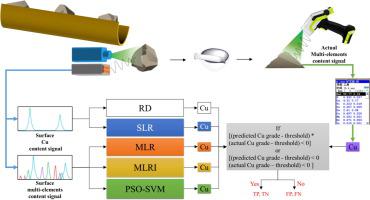当前位置:
X-MOL 学术
›
Int. J. Min. Sci. Technol.
›
论文详情
Our official English website, www.x-mol.net, welcomes your
feedback! (Note: you will need to create a separate account there.)
Enhancing XRF sensor-based sorting of porphyritic copper ore using particle swarm optimization-support vector machine (PSO-SVM) algorithm
International Journal of Mining Science and Technology ( IF 11.7 ) Pub Date : 2024-05-18 , DOI: 10.1016/j.ijmst.2024.04.002 Zhengyu Liu , Jue Kou , Zengxin Yan , Peilong Wang , Chang Liu , Chunbao Sun , Anlin Shao , Bern Klein
International Journal of Mining Science and Technology ( IF 11.7 ) Pub Date : 2024-05-18 , DOI: 10.1016/j.ijmst.2024.04.002 Zhengyu Liu , Jue Kou , Zengxin Yan , Peilong Wang , Chang Liu , Chunbao Sun , Anlin Shao , Bern Klein

|
X-ray fluorescence (XRF) sensor-based ore sorting enables efficient beneficiation of heterogeneous ores, while intraparticle heterogeneity can cause significant grade detection errors, leading to misclassifications and hindering widespread technology adoption. Accurate classification models are crucial to determine if actual grade exceeds the sorting threshold using localized XRF signals. Previous studies mainly used linear regression (LR) algorithms including simple linear regression (SLR), multivariable linear regression (MLR), and multivariable linear regression with interaction (MLRI) but often fell short attaining satisfactory results. This study employed the particle swarm optimization support vector machine (PSO-SVM) algorithm for sorting porphyritic copper ore pebble. Lab-scale results showed PSO-SVM outperformed LR and raw data (RD) models and the significant interaction effects among input features was observed. Despite poor input data quality, PSO-SVM demonstrated exceptional capabilities. Lab-scale sorting achieved 93.0% accuracy, 0.24% grade increase, 84.94% recovery rate, 57.02% discard rate, and a remarkable 39.62 yuan/t net smelter return (NSR) increase compared to no sorting. These improvements were achieved by the PSO-SVM model with optimized input combinations and highest data quality (=10, is XRF testing times). The unsuitability of LR methods for XRF sensor-based sorting of investigated sample is illustrated. Input element selection and mineral association analysis elucidate element importance and influence mechanisms.
中文翻译:

使用粒子群优化支持向量机 (PSO-SVM) 算法增强基于 XRF 传感器的斑岩铜矿石分选
基于 X 射线荧光 (XRF) 传感器的矿石分选可实现异质矿石的高效选矿,而颗粒内异质性可能会导致严重的品位检测错误,从而导致错误分类并阻碍技术的广泛采用。准确的分类模型对于使用局部 XRF 信号确定实际品位是否超过分选阈值至关重要。以往的研究主要使用线性回归(LR)算法,包括简单线性回归(SLR)、多元线性回归(MLR)和交互多元线性回归(MLRI),但往往达不到令人满意的结果。本研究采用粒子群优化支持向量机(PSO-SVM)算法来分选斑状铜矿石卵石。实验室规模的结果表明,PSO-SVM 优于 LR 和原始数据 (RD) 模型,并且观察到输入特征之间存在显着的交互效应。尽管输入数据质量较差,PSO-SVM 仍表现出了卓越的功能。实验室规模分选准确率达到93.0%,品位提高0.24%,回收率84.94%,废品率57.02%,与不分选相比,冶炼厂净收益(NSR)显着增加39.62元/吨。这些改进是通过 PSO-SVM 模型实现的,该模型具有优化的输入组合和最高的数据质量(=10,是 XRF 测试时间)。说明了 LR 方法不适合基于 XRF 传感器对研究样品进行分类。输入元素选择和矿物关联分析阐明了元素的重要性和影响机制。
更新日期:2024-05-18
中文翻译:

使用粒子群优化支持向量机 (PSO-SVM) 算法增强基于 XRF 传感器的斑岩铜矿石分选
基于 X 射线荧光 (XRF) 传感器的矿石分选可实现异质矿石的高效选矿,而颗粒内异质性可能会导致严重的品位检测错误,从而导致错误分类并阻碍技术的广泛采用。准确的分类模型对于使用局部 XRF 信号确定实际品位是否超过分选阈值至关重要。以往的研究主要使用线性回归(LR)算法,包括简单线性回归(SLR)、多元线性回归(MLR)和交互多元线性回归(MLRI),但往往达不到令人满意的结果。本研究采用粒子群优化支持向量机(PSO-SVM)算法来分选斑状铜矿石卵石。实验室规模的结果表明,PSO-SVM 优于 LR 和原始数据 (RD) 模型,并且观察到输入特征之间存在显着的交互效应。尽管输入数据质量较差,PSO-SVM 仍表现出了卓越的功能。实验室规模分选准确率达到93.0%,品位提高0.24%,回收率84.94%,废品率57.02%,与不分选相比,冶炼厂净收益(NSR)显着增加39.62元/吨。这些改进是通过 PSO-SVM 模型实现的,该模型具有优化的输入组合和最高的数据质量(=10,是 XRF 测试时间)。说明了 LR 方法不适合基于 XRF 传感器对研究样品进行分类。输入元素选择和矿物关联分析阐明了元素的重要性和影响机制。

































 京公网安备 11010802027423号
京公网安备 11010802027423号